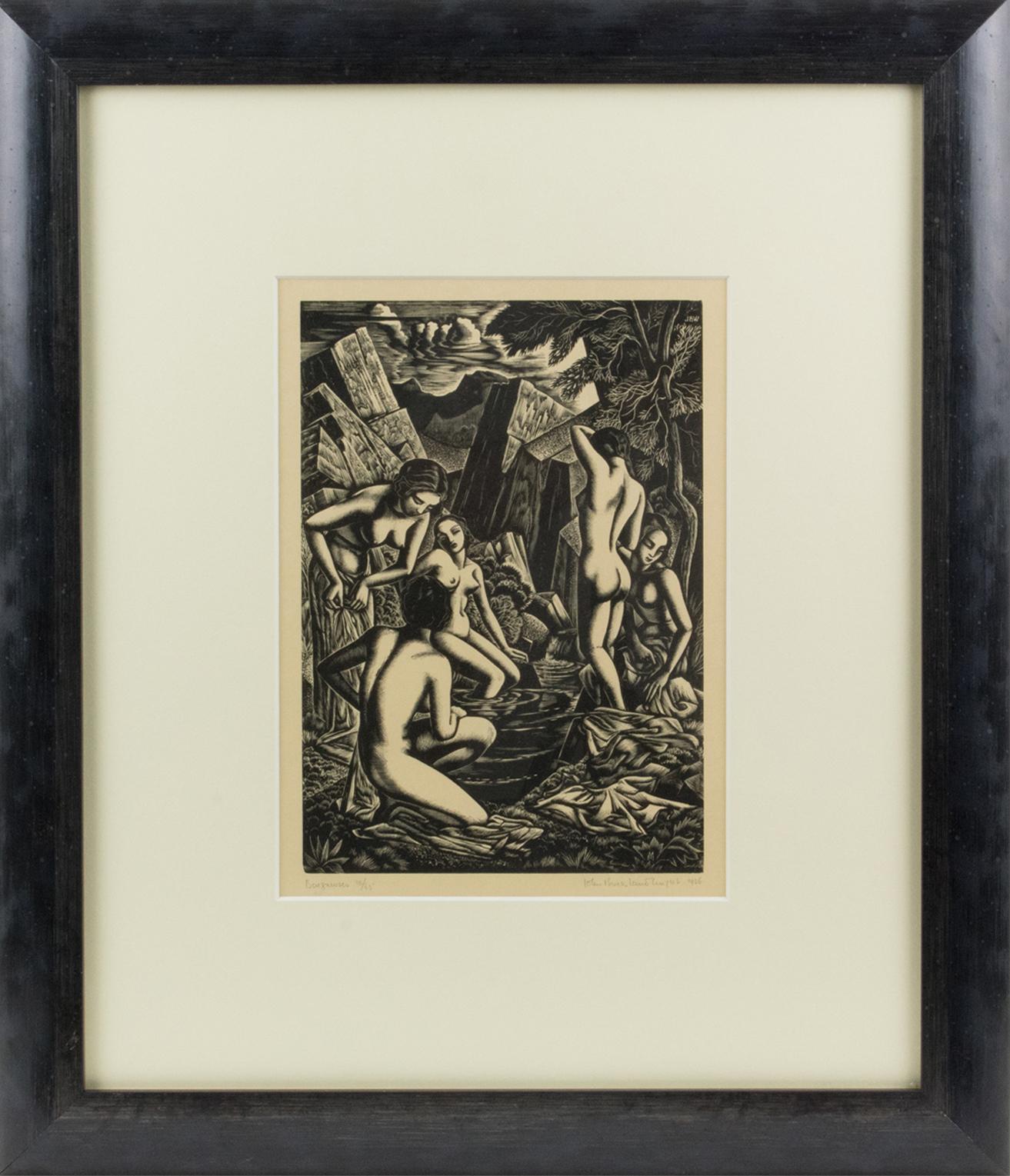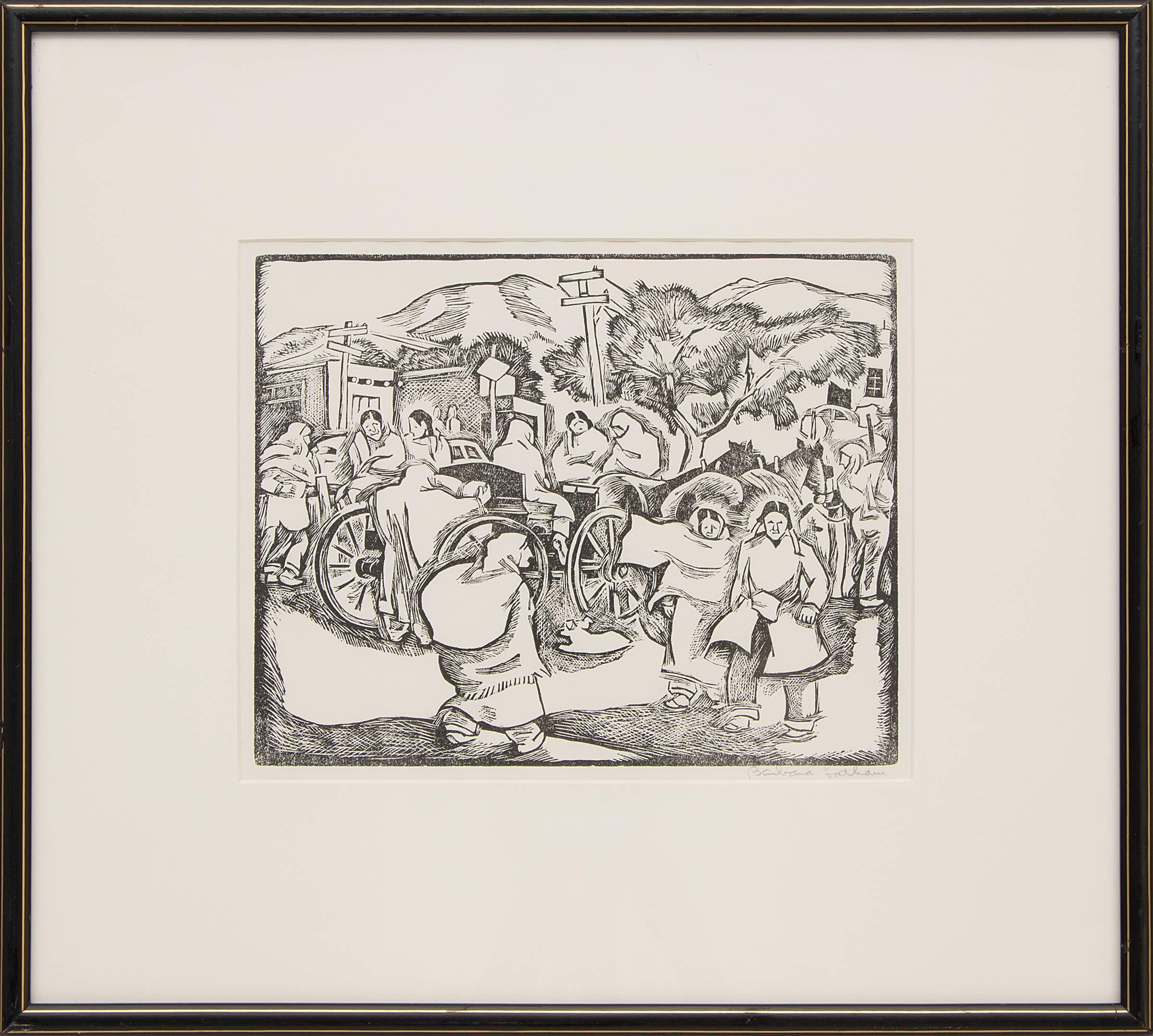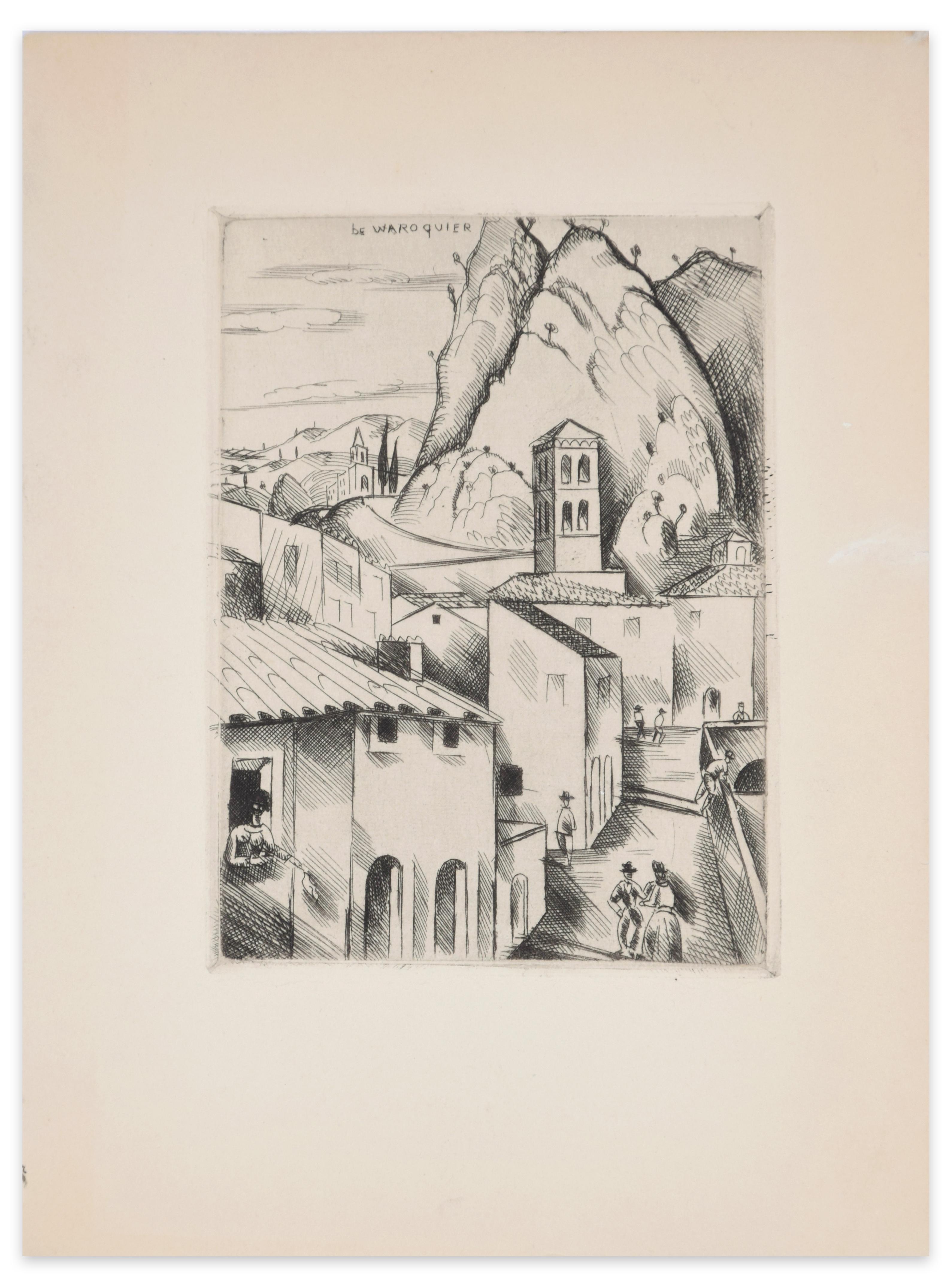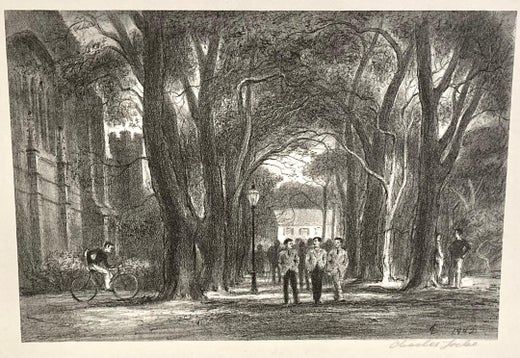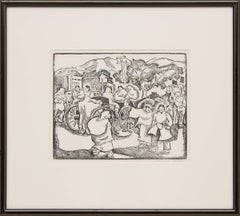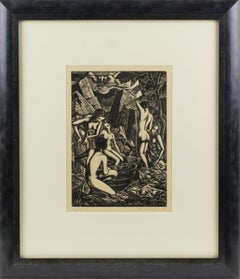Items Similar to 1930s Lithograph Print of Tourists at Garden of the Gods, Colorado Springs, CO
Want more images or videos?
Request additional images or videos from the seller
1 of 17
Charles Locke1930s Lithograph Print of Tourists at Garden of the Gods, Colorado Springs, COcirca 1935
circa 1935
$1,250
£935.61
€1,081.10
CA$1,733.33
A$1,941.56
CHF 1,009.39
MX$23,974.31
NOK 12,858.88
SEK 12,156.07
DKK 8,067.79
Shipping
Retrieving quote...The 1stDibs Promise:
Authenticity Guarantee,
Money-Back Guarantee,
24-Hour Cancellation
About the Item
"Photo Opportunity" is a stunning 1930s lithograph by Charles Wheeler Locke (1899-1983), showcasing a group of tourists amidst the breathtaking red rock formations of Garden of the Gods in Colorado Springs, Colorado. This American Modernist scene, created around 1935, captures the awe-inspiring beauty of the park’s iconic sandstone landscapes. The piece is part of a limited edition of 30 and is presented in a custom black frame, with overall dimensions of 17 ¾ x 16 ¾ x ⅞ inches. The image itself measures 11 ¼ x 10 ⅜ inches.
The Garden of the Gods in Colorado Springs, renowned for its striking red rock formations, was discovered in 1859 by two surveyors. Upon encountering the remarkable landscape, M. S. Beach suggested it would be a perfect spot for a Biergarten, to which Rufus Cable, inspired by its grandeur, famously responded, “It is a fit place for the Gods to assemble.” The name "Garden of the Gods" has remained ever since.
About the Artist: Charles Wheeler Locke (1899-1983) was a renowned American artist, painter, illustrator, printmaker, and educator. Born in Cincinnati, Ohio, Locke studied at the Cincinnati Art Academy and later with the celebrated Joseph Pennell at the Art Students League in New York City. Recognizing Locke's exceptional talent, Pennell hired him as his primary assistant before selecting him as the Instructor of Lithography at the League, a position Locke held from 1922 to 1937.
Locke gained international recognition for his lithographs depicting New York's docks, wharves, and city streets starting in 1925. He was an active member of several prestigious organizations, including the Society of American Etchers, the National Academy of Design, the American Print Makers, and the Century Club. His works continue to be celebrated for their detailed, evocative portrayal of American life and landscapes.
- Creator:Charles Locke (1899 - 1983, American)
- Creation Year:circa 1935
- Dimensions:Height: 17.75 in (45.09 cm)Width: 16.75 in (42.55 cm)Depth: 0.75 in (1.91 cm)
- Medium:
- Movement & Style:
- Period:
- Framing:Frame IncludedFraming Options Available
- Condition:
- Gallery Location:Denver, CO
- Reference Number:Seller: 258101stDibs: LU27310742062
Charles Locke
Charles Wheeler Locke Born 1899, Cincinnati Ohio
Died 1983, Garrison New York Charles Wheeler Locke – painter, illustrator, print maker, and teacher – was born in Cincinnati, Ohio in 1899. He studied at the Cincinnati Art Academy and later with Joseph Pennell at the Art Students League in New York City. Noticing Locke’s talents, Pennell hired him as his primary assistant before selecting him to succeed him as Instructor of Lithography. Locke held that position between 1922 and 1937. Beginning in 1925, his lithographs of the docks, wharfs, and streets of New York and Brooklyn gained international recognition. He was a member of the Society of American Etchers, National Academy of Design, American Print Makers, and the Century Club.
About the Seller
5.0
Gold Seller
Premium sellers maintaining a 4.3+ rating and 24-hour response times
Established in 1979
1stDibs seller since 2013
289 sales on 1stDibs
Typical response time: 13 hours
- ShippingRetrieving quote...Shipping from: Denver, CO
- Return Policy
Authenticity Guarantee
In the unlikely event there’s an issue with an item’s authenticity, contact us within 1 year for a full refund. DetailsMoney-Back Guarantee
If your item is not as described, is damaged in transit, or does not arrive, contact us within 7 days for a full refund. Details24-Hour Cancellation
You have a 24-hour grace period in which to reconsider your purchase, with no questions asked.Vetted Professional Sellers
Our world-class sellers must adhere to strict standards for service and quality, maintaining the integrity of our listings.Price-Match Guarantee
If you find that a seller listed the same item for a lower price elsewhere, we’ll match it.Trusted Global Delivery
Our best-in-class carrier network provides specialized shipping options worldwide, including custom delivery.More From This Seller
View AllSaturday Morning Market, Taos Plaza, New Mexico, 1950s Figural Linocut Print
By Barbara Latham
Located in Denver, CO
"Saturday Morning (Market, Taos Plaza, New Mexico)" is a striking 1950s modernist linocut print by renowned New Mexican artist Barbara Latham. This vivid print captures a bustling Sa...
Category
Mid-20th Century American Modern Figurative Prints
Materials
Linocut
"Prospector's Cabin" – 1937 WPA-Era Lithograph by Archie Musick, Modernist Art
By Archie Musick
Located in Denver, CO
This original, signed lithograph titled "Prospector's Cabin" was created circa 1937 by acclaimed American Modernist artist Archie Musick (1902–1978). A powerful example of WPA-era ar...
Category
1930s American Modern Landscape Prints
Materials
Lithograph
1930s Black and White Lithograph of House at Gregory Point, Colorado Landscape
By Arnold Rönnebeck
Located in Denver, CO
This original lithograph by renowned modernist Arnold Ronnebeck (1885-1947) depicts a charming home in Gregory Point, near Central City, Colorado. Created during the 1930s, this piec...
Category
1930s American Modern Landscape Prints
Materials
Paper, Lithograph
Silver Mine, Russell Gulch, CO (12/25) 1930s American Modern Lithograph Print
By Arnold Rönnebeck
Located in Denver, CO
"Silver Mine, Russell Gulch (12/25)" is a captivating black and white lithograph by American artist Arnold Ronnebeck. The piece features a mining scene in Russell Gulch, Colorado, wi...
Category
1930s American Modern Figurative Prints
Materials
Lithograph
1933 American Art Lithograph, Clear Creek Canyon by Ross Braught, Colorado
By Ross Eugene Braught
Located in Denver, CO
This striking original lithograph, Clear Creek Canyon I (Colorado), was created in 1933 by acclaimed American artist Ross Eugene Braught (1898–1983). A master of landscape and form, ...
Category
1930s American Modern Landscape Prints
Materials
Lithograph
1953 Signed Black & White Etching Print 'Ceremonial Day at Taos' New Mexico
By Gene Kloss
Located in Denver, CO
"Ceremonial Day at Taos" is a captivating vintage black and white etching by renowned American artist Gene Kloss. Created in 1953, this drypoint etching depicts the vibrant life of T...
Category
1950s American Modern Landscape Prints
Materials
Etching
You May Also Like
The Bathers, Wood-Engraving Drawing Lithograph by John Buckland-Wright
By John Buckland-Wright
Located in Atlanta, GA
This elegant wood-engraving charcoal drawing lithograph print was designed by John Buckland-Wright (1897-1954). The piece is signed, dated, titled, and numbered in pencil on the marg...
Category
1930s Art Deco Figurative Prints
Materials
Paper, Ink
Early 20th Century Camping in Sierra Mountains Lithograph
Located in Soquel, CA
Wonderful hand-colored lithograph of Sierra Mountain camping scene by Donald Masefield Easton (American, 1896 - 1956), published in 1931. Signed lower right (partially obscured by mat). Presented in rustic wood frame under glass. Image size: 14"H x 18"W.
Donald Masefield Easton was a painter, illustrator with his subjects being California landmarks and western scenes. Born is Port Costa...
Category
1930s American Impressionist Landscape Prints
Materials
Paper, Oil Crayon, Ink
"Conquering The Wilderness" - Lewis and Clark Expedition Original Etching
By Robert Hogg Nisbet
Located in Soquel, CA
"Conquering The Wilderness" - Lewis and Clark Expedition Original Etching
Original 1932 black and white etching titled "Conquering The Wilderness" by Robert Hogg Nisbet (American, ...
Category
1930s American Impressionist Figurative Prints
Materials
Laid Paper, Etching
"Bathers" by John E. Costigan, Original Limited Edition Signed Etching
By John Edward Costigan
Located in New York, NY
This original, limited edition etching, was realized by the esteemed American artist John E. Costigan, circa 1930. He is represented in the collections of the Metropolitan Museum, th...
Category
Vintage 1930s American Art Deco Prints
Materials
Paper
High Provence (Haute Provence) - Original Etching by H. de Waroquier - 1930
Located in Roma, IT
High Provence is an original etching artwork realized in 1930 ca. by Henri De Waroquier.
Signed on the plate at the top of the image, titled in pen...
Category
1930s Figurative Prints
Materials
Etching
Rural Scene - Etching by Paul Emile Colin - 1930 ca.
Located in Roma, IT
Etching and drypoint realized by Paul Emile Colin in 1930s.
Edition of 5/60. Hand signed and numbered in pencil.
Very good condition.
Category
1930s Modern Figurative Prints
Materials
Etching
$324 Sale Price
25% Off
